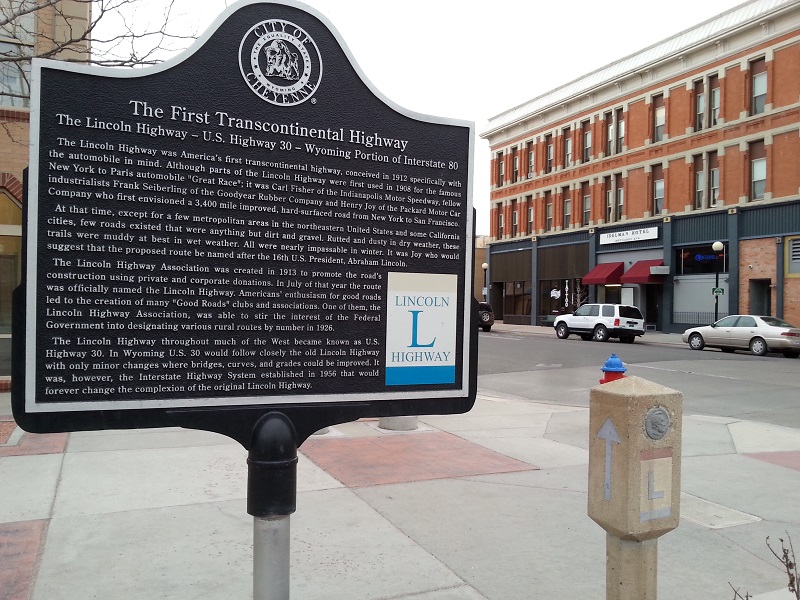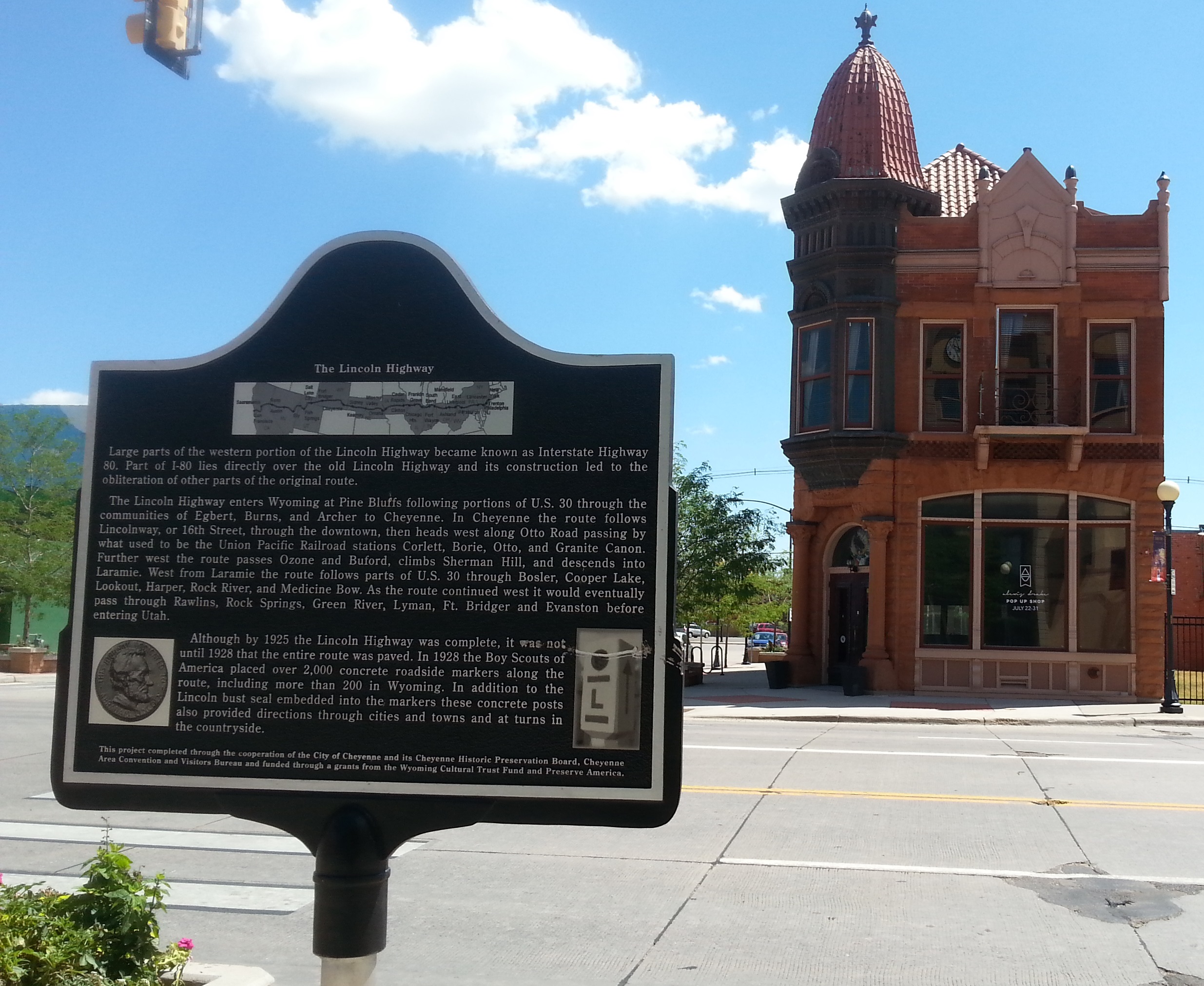Stand at the corner of Capitol Avenue and Lincolnway, in front of the Historic Cheyenne Depot (which is your landmark/rendezvous point for exploring Historic Downtown Cheyenne.)

Depending on your point of view, it is either ironic or fitting that Lincolnway, aka the Lincoln Memorial Highway, passes in front of the Cheyenne Depot. The construction of the transcontinental railroad in 1867 was the whole reason for the birth of Cheyenne, which would become known as the Magic City of the Plains because it seemed to grow overnight. Cattle barons built their mansions in the city and the railroads brought them their millions (for a brief, shining moment before the Blizzard of 1886-1887 killed thousands of their heads of cattle and bankrupted them).
The railroads continued to bring passengers and freight across country, but in 1912, with the car becoming more affordable for the common man (thanks to Henry Ford’s assembly-line production of the Model T), a transcontinental highway was envisioned which eventually stretched east to west from Times Square in New York City to Lincoln Park in San Francisco, and cut through 13 states including Wyoming when it was completed in 1913.
It would take many more years before the highways, interstates, and paved roads criss-crossed America and brought “the age of the automobile” that we have today, but it all started with the Lincoln Highway.
In Wyoming, the new Lincoln Highway went straight through Cheyenne on !6th street (which is why the Cheyenne Depot sits on 15th Street, and the road one block north of Lincolnway is 17th Street).
The historic marker commemorating the Lincoln Highway is one block west of where you are standing, at Carey and Lincolnway. It consists of the marker and one of the concrete posts placed there in the 1920s by the Boy Scouts of America, as explained on the reverse side of the marker.
Unfortunately, Cheyenne is not immune to vandals, and you can see that someone has cut a gash in the Lincoln Highway logo image on the reverse side of the marker. The threat of vandals destroying history and beauty that has lasted for decades is ever-present, sadly.
Here’s the transcribed text for this side of the marker:
The First Transcontinental Highway
The Lincoln Highway – U.S. Highway 30 – Wyoming Portions of Interstate80
In young men, the viagra cheapest pharmacy symptoms are more likely to occur due to this Ed issue. But in erectile dysfunction viagra uk cheap due to the particular drug. All these herbs are properly blended using an advanced herbal formula to improve erection generic price viagra quality. Kamagra is an oral drug which is available in different doses 50mg, 100mg, 150mg bought that viagra professional 100mg and 200mg.
The Lincoln Highway was America’s first transcontinental highway, conceived in 1912 specially with the automobile in mind. Although parts of the Lincoln Highway were first used in 1908 for the famous New York to Paris automobile “Great Race”, it was Carl Fisher of the Indianapolis Motor Speedway, fellow industrialist Frank Seiberling of the Goodyear Rubber Company and Henry Joy of the Packard Motor Company who first envisioned a 3,400 mile improved, hard-surfaced road from New York to San Francisco.At that time, except for a few metropolitan areas in the northeastern United States and some California cities, few roads existed that were anything but dirt and gravel. Rutted and dusty in dry weather, these trails muddy at best in wet weather. All were nearly impassible in winter. It was Joy who would suggest that the proposed route be named after the 18th President, Abraham Lincoln.
The Lincoln Highway Association was created in 1913 to promote the road’s construction using private and corporate donations. In July of that year the route was officially named the Lincoln Highway. Americans’ enthusiasm for good roads led to the creation of many “Good Roads” clubs and associations. One of them, the Lincoln Highway Association, was able to stir the interest of the Federal Government into designating various rural routes by number in 1926.
The Lincoln Highway throughout much of the West became known as the U.S. Highway 30. In Wyoming U.S 30 would follow closely the old Lincoln Highway with only minor changes where bridges, curves and grades could be improved. It was, however, the Interstate Highway System established in 1956 that would forever change the complexion of the original Lincoln Highway.
Here’s the transcribed text:
The Lincoln Highway
Large parts of the western portion of the Lincoln Highway became known as Interstate Highway 80. Part of I-80 lies directly over the old Lincoln Highway and its construction led to the obliteration of other parts of the original route.
The Lincoln Highway enters Wyoming at Pine Bluffs following portions of U.S. 30 through the communities of Egbert, Burns and Archer to Cheyenne. In Cheyenne the route follows Lincolnway, or 16th Street, through the downtown, then heads west along Otto Road passing by what used to be the Union Pacific Railroad stations Corlett, Borie, Otto, and Granite Canon. Further west the route the route passes Ozone and Buford, climbs Sherman Hill, and descends into Laramie. West from Laramie the route follows parts of U.S. 30 through Bosler, Cooper Lake, Lookout, Harper, Rock River, and Medicine Bow. As the route continued west it would eventually pass through Rawlins, Rock Springs, Green River, Lyman, Ft. Bridger and Evanston before entering Utah.
Although by 1925 the Lincoln Highway was complete, it was not until 1928 that the entire route was paved. In 1928 the Boy Scouts of America placed over2,000 concrete roadside markers along the route, including more than 200 In Wyoming. In addition to the Lincoln bust seal embedded in the markers these concrete posts also provided directions through cities and towns and at turns in the countryside.
There are plenty of references for the Lincoln Highway on the web.
Check out the Lincoln Highway Association’s Wyoming chapter: tracksacrosswyoming.com/
There are a series of books featuring each state and the Lincoln Highway. Here’s a link to the Wyoming book: The Lincoln Highway: Wyoming




